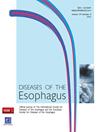528. IMPACT OF SARCOPENIA AND MYOSTEATOSIS ON THE SURGICAL OUTCOME OF PATIENTS WITH ESOPHAGEAL CANCER
IF 2.3
3区 医学
Q3 GASTROENTEROLOGY & HEPATOLOGY
引用次数: 0
Abstract
Background Alterations in muscle mass, sarcopenia and myosteatosis might negatively affect the surgical outcome of patients with cancer. Body composition correlation with biochemical markers and impact on surgical outcome in esophageal cancers is yet to be fully determined. Study design Patients with esophageal and esophageal-gastric junction cancer undergoing resection with curative intent were enrolled in a prospective clinical trial from to 2019 to 2023. Patients were assessed at presentation for anthropometric measures, past medical history and biohumoral markers. Contrast-enhanced CT-scans were used to analyze body composition and to detect low lumbar skeletal muscle index (SMI) and low mean muscle attenuation. We investigated the association between the presence of sarcopenia and/or myosteatosis and malnutrition or systemic inflammatory state. Results We enrolled 130 esophagogastric cancer patients who underwent Ivor-Lewis esophagectomy. Postoperative morbidity was not significantly higher in the sarcopenic group compared to non-sarcopenic patients (p=0.35). Myosteatosis and albumin level weren’t associated with post-operative morbidity (p=0.11). No differences in overall survival were found in patients with myosteatosis or sarcopenia compared to subjects with normal body composition (p=0.12 and p=0.16). Conclusion Our preliminary data shows no significant correlations between sarcopenia and myosteatosis and postoperative outcome and survival following esophagectomy for esophageal cancer. These findings from an high volume center suggest that factors other than these body composition parameters may play a more significant role in determining postoperative outcomes in patients undergoing esophagectomy. Further research is warranted to elucidate additional prognostic indicators and optimize patients care in this population.528.肌少症和肌骨骼疏松症对食管癌患者手术效果的影响
背景 肌肉质量的改变、肌肉疏松症和肌骨软化症可能会对癌症患者的手术效果产生负面影响。身体成分与生化指标的相关性以及对食管癌手术效果的影响尚未完全确定。研究设计 2019 年至 2023 年期间,一项前瞻性临床试验招募了接受根治性切除术的食管癌和食管胃交界癌患者。患者在就诊时接受人体测量、既往病史和生物体液指标评估。对比增强 CT 扫描用于分析身体组成,并检测低腰部骨骼肌指数(SMI)和低平均肌肉衰减。我们还研究了肌少症和/或肌骨质疏松症与营养不良或全身炎症状态之间的关联。结果 我们对 130 名食管胃癌患者进行了 Ivor-Lewis 食管切除术。与非肌无力患者相比,肌无力组的术后发病率并无明显升高(P=0.35)。肌松症和白蛋白水平与术后发病率无关(P=0.11)。肌骨疏松症或肌肉疏松症患者的总生存率与身体成分正常的患者相比没有差异(p=0.12 和 p=0.16)。结论 我们的初步数据显示,肌少症和肌骨质疏松症与食管癌食管切除术的术后效果和存活率之间没有明显的相关性。这些来自一个高产量中心的研究结果表明,除了这些身体成分参数外,其他因素在决定食管切除术患者的术后效果方面可能发挥着更重要的作用。有必要开展进一步的研究,以阐明更多的预后指标,并优化该人群的患者护理。
本文章由计算机程序翻译,如有差异,请以英文原文为准。
求助全文
约1分钟内获得全文
求助全文
来源期刊

Diseases of the Esophagus
医学-胃肠肝病学
CiteScore
5.30
自引率
7.70%
发文量
568
审稿时长
6 months
期刊介绍:
Diseases of the Esophagus covers all aspects of the esophagus - etiology, investigation and diagnosis, and both medical and surgical treatment.
 求助内容:
求助内容: 应助结果提醒方式:
应助结果提醒方式:


